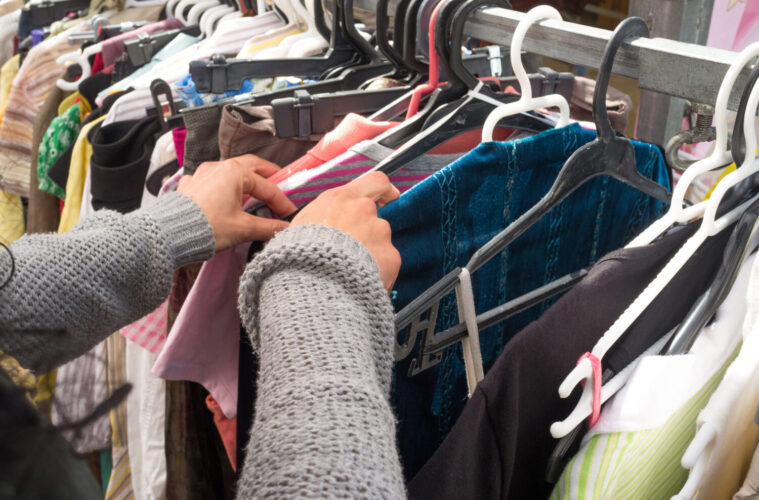Thrifting is awesome. Nowadays, most of us are “woke” enough to understand that avidly supporting fast fashion is one we can do without — and, as much as possible, buying second hand clothing is the way to go. Unfortunately, when it comes to thrifting, there’s more to it than meets the eye — and it’s not always good.
Find out what really goes on in the second hand apparel industry.
Why Buying Second Hand Clothing Is Cool
The most well-known positive effect of buying second hand items is that it’s a sustainable solution. So far, there hasn’t been a large-scale study that disputes this — as there is data to prove how thrifting reduces carbon footprint. According to the World Resources Institute, producing a single — yep, as in just one! — cotton shirt takes 2,700 liters of water. Additionally, based on 2018 data from the Environmental Protection Agency, 17 million tons of textiles end up in landfills.
Thrifting a single dress, however, reduces 21.4 pounds of carbon emissions (according to a study by Green Story (that thredUp commissioned) — that’s already 21.4 pounds less carbon footprint compared to a factory manufacturing a new one.
Other than the stats that show the environmental impact of buying second hand clothing, thrift stores are also where “great finds” are stored — from designer brands that are hiding in between other clothing to vintage gems, places like Goodwill and the Salvation Army have amazing deals that can suit anyone’s personal taste. Furthermore, whether it’s a person’s thrifting skills or their eco-conscious solution that can help Mother Earth, wearing second hand clothes is something to be proud of.
Why Buying Second Hand Clothing Is Getting too Expensive
According to thredUp, by 2026, the second hand clothing industry will grow three times faster than the regular apparel industry. However, certain problems may arise or continue to grow bigger as well.
Here are a few thrifting dilemmas that some are not aware of:
Greedy resellers make second hand clothing unattainable for those who need bargain pricing
Thrifting may just be an option for you, but to some, second hand clothes are all that they can afford. Homeless people or those who live in marginalized communities may find that brand-new retail clothes are still too expensive. If more people thrift, fewer pieces of clothing will be left available for them to buy.
Moreover, some Gen Z and Millennials resell their thrifted finds. In the same thredUp data, it says that “21% of Gen Z would pay more for clothing they know they can resell” and it may be because, according to the second hand marketplace, “59% of those who bought secondhand for the first time in 2021 say it gives them bragging rights.”
Gen Z and Millennial second hand clothing resellers sell their thrifted items online at a marked-up price that’s no longer affordable to many. They often advertise these clothes as “vintage” and “rare” to lure their audience into purchasing the items. Some post it on their TikTok accounts while others sell their “thrift hauls” at Poshmark or Depop. As a result, these second hand items turn from thrifted goods to “rare finds” — which can make it seem that these items are premium.
Your wardrobe may not be the clothes’ final destination.
Owning thrifted items can give people a sense of fulfillment because they know they did something sustainable. However, not many think about what happens when they don’t want the clothes anymore. If these clothing items get disposed of, the textile waste problem will repeat. As such, buying and then throwing away clothes (even though they’re second hand) isn’t all that sustainable.
The global apparel industry can possibly lay off workers.
Thrifting may be trendy and is expected to become even trendier, but many laborers rely on the apparel industry to earn money. If fewer clothes will get manufactured and sold in retail stores, there will also be fewer job opportunities for them.
However, second hand clothes haven’t overtaken the fast fashion industry. And it’s also nearly impossible that textile production will be eradicated in the future. So far, thrifting becoming a global phenomenon hasn’t posed a worldwide problem that the countries’ workforces and governments should be concerned about yet.
Summary
Compared to buying new clothes, thrifting is still the better option. However, not many realize that buying second hand clothing should be done only when one needs to — not because one wants to. Other people buy from thrift stores because they’re all the clothing that they can afford. If more people thrift, fewer clothes will be left for them. Moreover, even if they chance upon thrifted items from resellers, they’re now marked up to the point that the prices are no longer a bargain for them.
Advertising disclosure: We may receive compensation for some of the links in our stories. Thank you for supporting LA Weekly and our advertisers.

